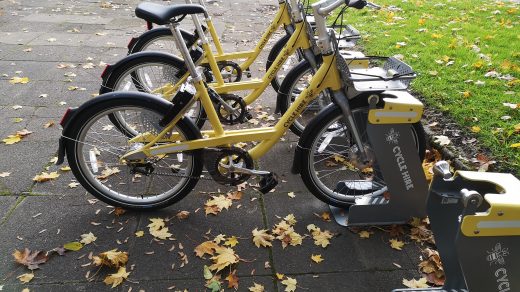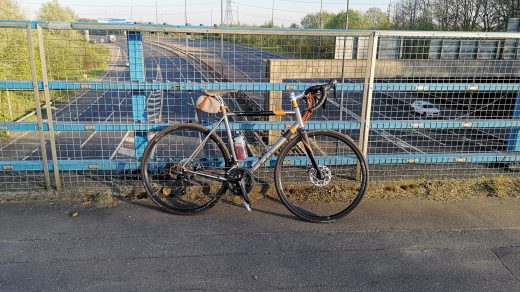On Thursday 18 January 2018, a fairly standard January morning – a little grey and drab but generally reasonable cycling conditions for the time of year – I cycled the five miles or so to work.

The camera-equipped winter commuter bike: prominent forward-facing Garmin Virb camera on the handlebars, the rear-facing Cycliq Fly 6 combined light/camera on the seatpost.
About a mile into my ride, I noticed a teenage lad cycling ahead of me who, despite doing everything right, experienced at least five very close calls due to bad driving. I tried to catch him up to ask if he was OK and would he like the footage from my handlebar cam, but before I could do so he had turned down a side road and I lost sight of him.

Lezyne Zecto light and Garmin Virb camera: you should see me; if not, I will damn well see – and record – you.
When I got to work, I had a look at the footage and, although the images of these close calls the lad had had were a little grainy due to the distance involved, I cropped them and used them in a Facebook post. The idea I was trying to get across was that no matter how well we cycle, or how visible we make ourselves, we still face disproportionate danger from the operators of motor vehicles and that this is a stark illustration of why the “be safe, be seen” approach to road safety is the wrong one:
This is not unusual for me: I often post accounts of things that happened on my commute which I discuss with my largely cycle-friendly chums, and occasionally also end up submitting footage to the police to enable them to deal with examples of particularly bad driving. When I uploaded this particular post, I noticed a number of friends were sharing it to their own timelines, so I made it public, thinking that friends of friends might also be interested in the message and the quite powerful photos illustrating it. Interestingly, the number of shares just kept rising throughout the morning.
My other half, who is far more Internet savvy than I, suggested I turn the post in a blog to then tweet to reach a wider audience, so I duly did so at:
https://bangingonaboutbikes.wordpress.com/2018/01/18/on-why-be-safe-be-seen-is-nonsense/
Given my own rather modest Twitter following, it was only really when my friends at Greater Manchester Cycling Campaign picked up the link to the blog and tweeted it to their very cycle-orientated followers that activity on Twitter started to pick up:
This morning @pootlers followed a clearly visible rider who experienced 5 near-crashes in less than a mile: https://t.co/LwVKjkDmHR
"This is why arguments about dayglo clothing, lights by day, foam hats etc. are a complete distraction from what the real issue is"— GM Cycling Campaign 🐝🚲 (@GMcycling) January 18, 2018
By the end of Thursday, I’d had just over 1,000 blog views and was pleased that it seemed to be getting decent exposure. I wasn’t prepared for what Friday would bring (though are we ever?). Shares, retweets, blog views and comments went through the roof; by the end of Friday Facebook shares and blog views were each in excess of 7,000; at the time of writing (Sunday afternoon, three days after publication), we’re at 11,000 Facebook shares (shares presumably being read by multiple people), 13,000 blog views and a shed load of Twitter activity that’s less easy to monitor (for instance, someone screenshotted and tweeted the Facebook post, and that, too, took on a life of its own without registering in any statistics).
The sentiment has clearly really struck a chord in people who cycle in the UK and further afield, and I have to say, given the ill-tempered nature of a lot of discussion around cycling, the resonance has been overwhelmingly, heart-warmingly positive. There has, of course, been some dissent, as ever on the Internet, so I thought as a follow-up I’d review some of the comments, ideas and arguments that the original post has thrown up during its unexpectedly extensive travels through cyberspace (typos the respective authors’ own, of course).
1) I agree entirely…
…or there’s an astounding number of people who are frankly fed up of being told that the danger they face on the road is their own fault for not wearing the right clothes or not cycling properly or some other arbitrary factor that may or may not influence the conduct of people in charge of vehicles. This was the essential point I was trying to get across: no matter how perfectly we cycle, no matter how visible we make ourselves, the roads will never be truly safe unless the source of the actual risk – bad driving – is addressed. Many, many people understood this point and related their experiences:





Et cetera, et cetera, et cetera. The bottom line is that being visible is no guarantee to safety: what matters is getting drivers to care about the safety of people on bikes. And gratifyingly large numbers of people also got this point. If we’re to make any progress on safe cycling we need to stop obsessing about yellow coats and start looking at factors such as credible, effective policing, fit-for-purpose driver training and further training, and a built environment built for people, not vehicles, and that aspires to a vision-zero approach. Sadly, however, many people do still obsess about yellow coats and wanted to talk about that, instead.
2) Hi-vis is good because it might still reduce the risk a little bit…
…or I’ll focus my risk-reduction efforts on something you’ve just demonstrated to be of marginal effectiveness. There is more logic to this point than some of the others: after all, if by wearing eyeball-searingly bright clothing a few more drivers may not crash into you, what’s there to lose? Well, time and energy debating a less relevant point, for starters. Here’s a typical exchange:

To which I replied:

What particularly bothers me about this argument is that it’s the language of bullying: “Wear this and I’ll only intimidate you a bit. Imagine what I could do to you if you weren’t wearing it. You watch your step now.” And a transport system based on the language of bullying has no place in a civilised society, and should be vigorously resisted.
3) Some people cycle in dark clothes with no lights at night…
…or your thesis is so incontrovertibly correct that I want to derail it by talking about something completely different yet superficially related. This was a particularly baffling curveball tossed in not only by anti-cycling trolls, but also by a lot of people who cycle themselves. The only logical explanation I can think of is that this trope has become so prevalent that many of us, no matter how sympathetic we are to the two-wheeled cause, have absorbed this as part of the whole “wear the right clothes and you’ll be fine” line (and the converse: car/bike crashes are probably the rider’s fault cause they’re probably doing something or other wrong), even though we all know that to be untrue.
What particularly irked me about this was the almost Pavlovian reflex among pedallers and non-pedallers alike: “if you’re dissing hi-vis, then you must be advocating dark clothes and no lights at night.” Which is a bonkers conclusion. What many hadn’t considered is that it should be possible to cycle in regular clothes with lights at night – i.e. perfectly legally – without experiencing road aggression etc. And if we’re to raise levels of cycling, then that’s precisely the type of rider we want to see more of on our roads.
Here are a couple of exchanges on those lines:


Or, from the blog:

4) Yeah but cyclists are annoying…
…or I have a short temper and shouldn’t really be operating heavy machinery in public. The examples speak for themselves. If this is how you react to situations that irk you, then perhaps follow this link and do us all a favour: https://www.gov.uk/giving-up-your-driving-licence.


5) And hundreds of friend requests…
…or what makes you think we’d get on just because you read my post. This has been one of the most baffling outcomes of having a viral post, but I guess that’s social media for you.
So there we go. Those are the main points I saw as a result of posting my experience cycling to work the other morning. I’m sure there were lots more as I don’t get word of what happens on shares and so on. But it’s great to have started a conversation and got people engaged in a discussion of cycle safety issues, and by doing so hopefully generated a little solidarity in terms of how we need to push for change.
On a closing note, I’d really like to see the lad again, let him know what’s been going on and gauge his impressions of cycling in Prestwich. I’ll let y’all know if I do. Thanks as ever for engaging.





My experience is that most drivers are ok around cyclists but some behave as if we don’t exist – therefore for these drivers high viz or not it makes no difference. This morning an oncoming car swerved on to my side of the road to avoid a puddle. I had to brake to avoid a collision or close encounter. I am pretty sure he wouldn’t do that to a car. When I took driving lessons over 50 years ago I was taught to take care around cyclists. A few months ago when out on my Sunday morning ride I was forced off the road by a driving instructor car with one occupant – presumably a driving instructor. It made me wonder what learner drivers are taught today about cyclists.
Very little, I understand. New drivers lack confidence around cyclists and many try to conceal that with bravado. And given how few children cycle these days, they also won’t have the experience of cycling themselves. So, we’re looking at a generation or two before any widespread attitude change, even if we start now. But keeping going is key: the more bikes there are on the road, the more used people get to driving around them.
The main reason for this isn’t driver negligence. It is natural cognitive bias. Cyclists are small. It is quite easy for someone scanning the road to not see a cyclist *at all* due to the way our eyes skip over things. I had this happen to me last month – I was right in front of a car, less than 5 metres away, they were stopped at a give way intersection and I was cycling straight past. I saw them look in my direction, and then they pulled out right in front of me. If I hadn’t been moving slowly, I would have hit them. When I pulled out of the way, ending up right next to the driver’s window, he gave me a look of bewilderment like “where did you come from?”. He genuinely didn’t see me at all, despite his eyes looking around me.
The only way to prevent this is to scan very slowly and deliberately – but that has its own danger: there are frequent situations where that would be *more* dangerous.
Cyclists being small also means that we misjudge how fast they are moving. We naturally overrate the speed of large vehicles (trucks and buses), thinking we have less time before they are upon us than is actually the case, while we do the opposite with cyclists, thinking they are further away and moving slower because they’re smaller.
This is not something that can be solved by education, although that could help to some degree. Cycling will always be more dangerous than driving, unless you rig some large un-aerodynamic visual obstacle around the bicycle to make it wider.
BTW I’ve never worn high-vis and have had relatively few problematic instances in years of daily cycling. I do ride assertively, taking the center of the lane whenever it would be inappropriate to pass me, but ceding it where possible. Maybe I’m just lucky, but I do suspect you’re right and that high-vis has negligible impact.
I agree, and the solution to this is the kind of vision-zero urban engineering we see particularly in other northern European countries: we acknowledge that humans are fallible, and engineer an environment that forgives mistakes, rather than amplifies them, as here. I also eschew hi-vis (if you hadn’t already realised) and rely on assertive/defensive riding – and lights at night of course! Standard position where a car’s left wheels would be as that’s in the driver’s field of vision, primary position where overtaking is inappropriate; don’t keep a straight line as slight wobbles/uneven movements also attract drivers’ attention; also look round when you hear a car approaching – if they know you’re watching them, they will often start to behave. It’s amazing how effective the last one is.
I’ve just found your blog and started to read through some older posts. Whilst I do agree that we shouldn’t feel we “have” to wear hi viz, I ride almost exclusively on narrow, unlit country lanes and hi viz definitely helps here even during daylight. Without it you will blend into the surrounding greenery, with it, you look much bigger and way more obvious. Most, not all, drivers are courteous and you can respond accordingly.
Thanks for this. Yes indeed, rural cycling is a different kettle of fish and it probably makes sense to be a little more cautious. Though again, lowering speeds and increasing driver awareness is an important tactic there, too. My argument is essentially that focusing safety advice on what people wear on bikes doesn’t really address why people on bikes are put at risk in the first place. But I do appreciate what you’re saying. And welcome to the blog!
Thanks for this. Have posted a link on https://www.facebook.com/Australian-Cyclist-Threats-Database-376960219404163/
Isn’t there a study that shows the more safety gear a cyclist wears, it has the effect of making drivers actually drive closer because they think the cyclist is protected. Just proves the point that there is too much emphasis on what we wear as cyclists.